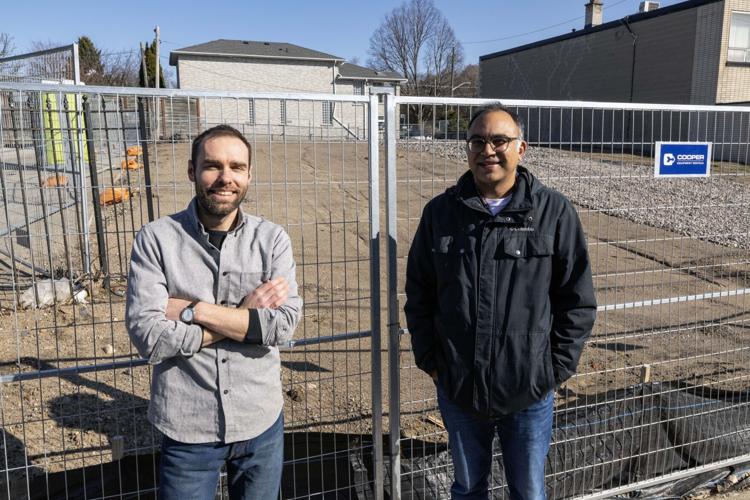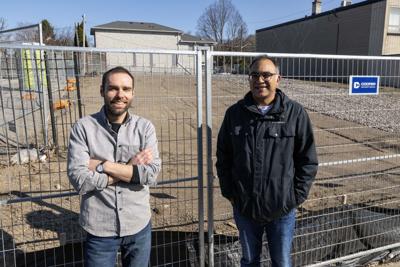Gautam Mukherjee knows his Etobicoke housing developmentĚýis an anomaly.
Two weeks ago, his team officially handed the reins of their property to a construction manager to start preparing the vacant site’s utilities and infrastructure to allow for a brand new, 38-unit apartment building to rise.
In doing so, his team crossed a threshold eluding other homebuilders citywide, some of whom have been forced to shelve or cancel projects due to a sluggish market and rising costs.Ěý
“Touch wood, right, about the tariffs? There’s some risk there,” Mukherjee cautioned. But if all goes smoothly, he hopes to open their doors in 2027.
Mukherjee’s optimism is far from the norm in today’s homebuilding market. But his team, at Houselink and Mainstay Community Housing, isn’t building only under their own steam. Their project is heavily backed by multiple levels of government, relying on funding and financing available specifically because they aren’t eyeing a profit. The developmentĚýalong the Queensway will provide deeply affordable housing for older adults with support services available on-site.
These kinds of government-backed housing projects are insulated in some ways from the forces currently battering the private development sector. While they face their own challenges,Ěýthese projects don’t rely on pre-construction buyers to start building like a condo. They also can access specialized loans and grants meant to keep them financially afloatĚý— and keep the wheels of construction turning — while privately funded projects stutter or hit the brakes.
While affordable rental housing still accounts for a sliver of Toronto’s total housing development, itĚýmade up a larger portion of overall housing starts across şŁ˝ÇÉçÇřąŮÍřlast year,Ěýcity and federal data shows —Ěýup to 4.14 per cent of starts in 2024 from 3.09 per cent in 2023, a 34 per cent increase.Ěý°Őłó±đĚýsector has ˛őłŮľ±±ô±ôĚýseen some pullback amid hostile market conditions,ĚýbutĚýthe data showsĚýthey’ve weathered the storm better than other housing types, with one Mainstay executive saying their sector is able to take advantage of less competition for land, contractors and materials.
These projects are vulnerable, instead, to a different force: what University of şŁ˝ÇÉçÇřąŮÍřhousing expert David Hulchanski calls the “whims of public policy.”
This kind of housing supply lives or dies with government choices, not only about the kind of housing prioritized, but the degree of support made available. In a spring marked by electionsĚý— first in Ontario, and now countrywide — the choices made at the ballot can have real consequences, he said.
Mukherjee looks at their project and sees its promise in terms of low-cost units forĚýa city in the grips of a housing affordability crisis — with soaring rents and risingĚýhomelessnessĚý— as well as inĚýkeeping the construction sectorĚýmoving in a time of private sector hesitance and risks from the Canada-U.S. trade war.
“The government support is making a big difference to the viability,” he said.Ěý
How the money works
The Queensway project began in 2022, when Mukherjee’s teamĚý— one of the largest non-profit players in Toronto’s affordable and supportive housing sphereĚý— bought the land occupied by two vacant, derelict lowrise structures with a handful of units between them.
The purchase price for the propertyĚýcame out of Houselink and Mainstay’s coffers, as did the cost to go through a city hall process to make technical changes to the building rules for the site. All-in, Mukherjee estimates their team will foot around 20 per cent of the project’s total $15-million cost.
Then came the question of financing the rest.
Building deeply affordable housing is a different balancing act from something like a new condo development, which ; or even a market-priced rental site, which can count onĚýthousands of dollars in monthly revenue per unit once construction is done.

A rendering prepared by Montgomery Sisam Architecture, shared with the Star by property owners Houselink & Mainstay Community Housing, of a future seniors supportive housing site being built along the Queensway in Etobicoke.
Montgomery Sisam ArchitectureWhile Houselink and Mainstay are contributing equity to the Queensway project,Ěýtheir development has also received support from two city grant programs, as well as backing from the federal Affordable Housing Fund, via grants as well as lower-cost financing. It’s that intervention that allows them to create sustainable, deeply affordable housing in today’s challenging market.
For the federal aid, Mukherjee says they needed to prove the project was viable, demonstrating, for example, that they had secured a “maximum price” deal for construction, meaning their contractors won’t charge them more than a certain price even if materials or other costs rise. By qualifying for the federal housing assistance program,Ěýthey have the certainty of a maximum interest rate, tied to the 10-year bond rate, which Mukherjee says sits around 2.8 per cent.
The exact rate will be locked in when the Houselink and Mainstay team officially begins using their mortgage, Mukherjee explainedĚý— something their team was looking to do “any day now” to firm up costs.Ěý
‘Everyone is much more keen for work’ĚýĚý
The Queensway project is among more than a dozen other affordable and supportive housing projects in şŁ˝ÇÉçÇřąŮÍřthat have entered construction, or that city hall expectsĚýto break ground, within this year. Houselink and Mainstay’s chief development officer, Josh Taylor, observed that their sector tends to be like this —Ěýmoving “counter-cyclical” to activity in the private market.
“Competition for land is way less than it was two years ago, and also there’s a whole kind of construction supply chain, from general contractors down to subs and suppliers, where everyone is much more keen for work,” Taylor said. He sees it as a chance for more “competitive” pricing and more flexible timing.Ěý
Across the Greater şŁ˝ÇÉçÇřąŮÍřand Hamilton Area, market research firm Urbanation has documented the constriction of the private market, with one recent report counting 28 presale condos with a combined 5,734 units put on hold, cancelled, placed into receivership or converted to rentals since the start of 2024, including four sites totalling 1,042 units in the first quarter of 2025.Ěý
But it hasn’t been all smooth sailing for nonmarket housing developmentsĚýeither.ĚýThese projects often work with razor-thin economic margins that don’t offer a cushion of profit to claw into when costs rise. And they aren’t immune to problems like supply chain disruptions and community pushback.
One site city hall points to as “significantly delayed” is aĚý59-unit supportive housing complex in WillowdaleĚý— whichĚýhas seen its plans repeatedly appealed, among other issues. (The prefabricated building pieces that have been sitting idle are now expected to be “craned into place” this spring, city hall says.)
On Kingston Road, a motel renovation and a new modular building with a combined 86 new supportive housing unitsĚýhas also been heavily delayed from its initial completion target of summer 2023. Just finished and now filling withĚýtenants, city hall blames “industry-wide challenges” for the setbacks, including supply chain shakeups, increased price-tags, materials shortages, and an “extensive upgrade” to the water main infrastructure on the property that required co-ordination with the owner next door.Ěý
No matter the hurdles that arise, receiving government funding also means hitting deadlines. For any sites funded under the federal Rapid Housing Initiative (RHI), a pandemic-era program aimed at creating deeply affordable and supportive homes under which the city has received $610.8 million, developmentsĚýmust beĚýcompleted within 12 months of approval if funded in the first two phases of the program, or within 18 months if fundedĚýin phase three.Ěý
Asked what happens if problems threaten those timelines, a City ofĚýşŁ˝ÇÉçÇřąŮÍřspokesperson said in city-led projects theyĚýwouldĚýuse the RHI program’sĚý“quarterly reporting process” to inform federal officials of any project delays and develop “strategies to recoverĚýthe schedule” — though no specifics on those strategies were shared.Ěý
City hall still faces a long road to hit its own targets, having aimedĚýfor 18,000 new supportive housing units between 2020 and 2030. The city says 1,103 have so far been built, with another 660 in other stages of development.
How politics changes the game
Doug Rollins, interim executive director ofĚýToronto’s housing secretariat, says there’s an overall feeling of “instability” across the building sector.
“The impact of tariffs and trade could have potential downstream impacts on supply chains and costs. Additionally, there’s a federal election,” Rollins said — voicing hope that whoever is elected keeps putting money into deeply affordable units.
As the federal campaignĚýplays out, prime ministerial hopefuls continue to unveil their policy pledges for housing. Some of those promisesĚýhave been similar — such as GST reliefĚý— though they differ in details. In their housing platform, the LiberalsĚýhaveĚývowed a $6-billion fund dedicated to “deeply affordable” and supportive housing, along with housing for Indigenous Peoples and homeless shelters. The Conservatives have promised to sell off 15 per cent of federally owned buildings, with a requirement that buyers turn those properties into affordable housing. The New Democrats have said they’d pursue a target of 20 per cent nonmarket housing “in every neighbourhood.”Ěý

The development site in Etobicoke. Developer Houselink and Mainstay Community Housing are breaking ground soon and hope to open doors on a new affordable housing site for seniors by 2027.
Nick Lachance şŁ˝ÇÉçÇřąŮÍřStarHulchanski, the University of şŁ˝ÇÉçÇřąŮÍřhousing policy expert, says the level ofĚýgovernment support forĚýnonmarket housingĚý— whether co-ops or other forms of deeply affordable rental housingĚý—Ěýhas clear ramifications for Torontonians. After higher governments stepped back from funding deeply affordable housing in the ‘90s, he said, cities began to see homelessness surge.
Since then, even when the private market was in full swing, the city has faced massive gaps for deeply affordable homes. In Toronto, there are now more than 100,000 households waiting for subsidized housing, plus tens of thousands more individuals waiting for affordable homes with supports.
“Whether it was 50 years ago or today, the market can’t build for low-income people,” Hulchanski said.
For now, across Toronto, numerous nonmarket housing projects are chugging on. In the last few weeks, city hall has proposed zoning changes needed to construct a 51-unit, mass-timber affordable housing site in Thistletown-Beaumond Heights, and announced the groundbreaking of a 159-unit charity-led affordable housing site in North York’s Westminster-Branson. Other in-construction sites include a 48-unit Elizabeth Fry Society of şŁ˝ÇÉçÇřąŮÍřdevelopment on Wellesley Street for women exiting the justice system,Ěýwhich city hall says it expects to be finishedĚýsometime this summer.ĚýĚý
Looking at the market today, Mukherjee believes affordable housing projects, backed by government supports, could play a role in keeping the construction sector moving during the private market slump.
“We can keep the development sector going by looking at things like non-profit and public projects. With respect to the overall economy, I think it’s really important,” Mukherjee said.
“And there’s an opportunityĚý— given what’s happening in the bigger picture.”


































To join the conversation set a first and last name in your user profile.
Sign in or register for free to join the Conversation